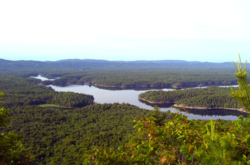This article needs additional citations for verification .(September 2018) |
| La Cloche Mountains | |
|---|---|
| La Cloche Range | |
 | |
| Geography | |
| Country | Canada |
| Province | Ontario |
| Range coordinates | 46°7′25″N81°45′05″W / 46.12361°N 81.75139°W [1] |
| Topo map | NTS 41I4 Whitefish Falls [1] |
The La Cloche Mountains, also called the La Cloche Range, are a range of mountains in Northern Ontario, Canada, along the northern shore of Lake Huron near Manitoulin Island. The mountains are located in the Canadian Shield, and are composed primarily of white quartzite. [2]
Contents
They extend roughly from La Cloche Provincial Park, south of Massey, to Killarney Provincial Park, southwest of Sudbury. The communities of West River, Willisville and Whitefish Falls are located directly within the range; the town of Espanola and the municipality of Killarney are located nearby, however they can be seen (from some vantage points) as far away as Manitoulin Island.
Ontario Highway 6 is the principal transportation route through the range.
Killarney Provincial Park is located in the range and is very popular among tourists. Another feature includes the "Heaven's Gate Trail" which traverses the length of the range from Willisville in the east to Massey in the west. Thought to be an old aboriginal trade route, it traverses the plateau of the range with the North Channel of Lake Huron visible to the south. The trail is particularly gruelling and is rarely traversed mostly due to its length and remoteness from major cities.




